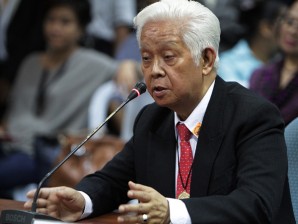Political ad spending to hit P2B; GMA 7, ABS-CBN to get bulk

Comelec Chairman Sixto Brillantes Jr. said political ads in the guise of commercial ads—candidate endorsing products or pushing for advocacies of their parties—would not be allowed during campaign. INQUIRER FILE PHOTO
Political ad spending is expected to hit P2 billion in this year’s midterm elections, with television networks hoping to continue to corner the bulk of the campaign pesos despite moves by the Commission on Elections (Comelec) to curb politicians’ commercials on the boob tube.
In a January 29 report by Deutsche Bank AG/Hong Kong on Philippine media companies, the projected P2 billion political ad spending this year is 66 percent higher than the P1.2 billion politicians spent during midterm elections in 2007.
Elections have become a massive source of income for broadcast companies every three years—political ads are expected to account for 5.2 percent of the P35 billion total ads this year compared to 4.8 percent of the P25 billion total ads spent in 2007.
ABS-CBN Broadcasting Corp. and GMA Network Inc. roughly have a 60-40 share of political ad revenues in broadcasting, although GMA has more profits than ABS-CBN (P2.971 billion to P2.5976 billion).
In comparison, political ads soared to P5 billion in the 2010 presidential elections, or 14.6 percent of the P35 billion total ad spending in the same year.
Article continues after this advertisement“Being the main advertising medium, we believe free-to-air TV is likely to get a lion’s share of election-related ads, as seen in the industry during the last presidential election in 2010,” Deutsche Bank analyst Carissa Mangubat said.
Article continues after this advertisementMangubat said she expected ABS-CBN and GMA to post double-digit growth of 11.6 percent and 13.1 percent, respectively, this year largely due to the triennial boost in political ad spending even with the Comelec’s move to impose a 120-minute cap on political ads for every candidate on all channels, harsher than the 120-minute limit for every candidate on each channel in 2010.
Mangubat said that since both networks had already maxed out on their ad loads (18 to 20 minutes per hour compared to the average 12 minutes per hour in Indonesia ), profits would come from premium priced ads such as ads endorsing candidates.
“Political ad rates are also regulated and are effectively priced at a 25 percent to 30 percent premium versus regular ad rates because rates are pegged directly to the published rate card. This could mean immediate margin enhancement for ABS-CBN and GMA,” Mangubat said.
Based on its forecasts, political ad spending would add 5 percentage points to 6 percentage points in revenue growth and 3 percentage points to 4 percentage points increase in profit margins.
But political experts are divided on who are the winners and losers in the Comelec’s move to restrict political ad spending this year.
Leveling playing field
Sen. Franklin Drilon, campaign manager of the Aquino administration’s Team Pinoy, does not see any winners or losers from the ad restrictions.
“To me, it is just to level the playing field between rich and poor candidates, which is the purpose of the law,” Drilon said yesterday.
Sen. Francis Escudero agreed, but said he reckoned that the ad limits would be a hard blow to the networks.
“There are five to eight candidates who can spend more than the 120-minute limit on all channels under the new Comelec guidelines,” Escudero said.
Sen. Vicente Sotto III said newspapers and tabloids could benefit from the ad limits on broadcast media.
“Some candidates might divert part of the budget for TV and radio to one-fourth page ads in newspapers or one-half page ads in tabloids,” Sotto said.
The new Comelec rules limit print ads to a maximum of three times a week for every publication.
“It’s not only cheaper than the P500,000 per 30-second spot on TV, which is literally gone in a blink of an eye, but print advertising offers more substance and more time for voters to review the qualifications of the candidates,” Sotto said.
“There will be no shift from one channel to another, money will move across different media,” he said.
Sotto said one of the biggest losers in the campaign reforms were the bus companies after the Comelec banned ads on their fleet and terminals during the campaign period. “Bus ads are one of the most cost efficient campaign tools. It helped me win in 2010,” said Sotto.
No ads on buses
The Comelec prohibits political ads on buses and bus terminals during the campaign from February 12 to May 11.
The Comelec said any infringement of the rule would be “cause for the revocation of the public utility franchise and will make the owner and or operator of the transportation service and or terminal liable for an election offense under Section 9 of Republic Act No. 9006.”
An official of one of the biggest bus companies operating in Metro Manila said the decision would be a big blow to the industry, which was hoping to cash in on the multibillion-peso election spending that would have generated P10,000 a month for ads on the rear of buses.
Inquirer research showed that as of December last year, there were 8,077 bus franchises registered nationwide with a combined fleet of 26,483 buses.
In Metro Manila there were 391 franchises that ran 5,342 buses.
The bus company official said most operators expected to generate at least P100 million in monthly income from political ads during the campaign.
Comelec Chairman Sixto Brillantes Jr. said political ads in the guise of commercial ads—candidate endorsing products or pushing for advocacies of their parties—would not be allowed during campaign.
Brillantes has also indicated he wants the spending limit of candidates to P3 for every voter strictly enforced.